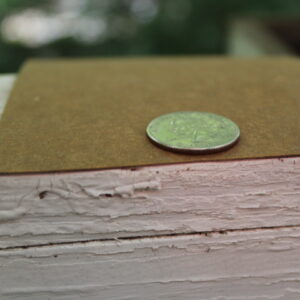Having problems first time veneering
I’ve got this unusual project going on where I’m trying to produce what I’ll call veneer wafers. I’m getting raw veneer from mbveneer.com and the goal is to back it with something very thin for support and to have it come out of the clamps perfectly flat, and as thin as possible. Instead of using the pricey stuff I’m first practicing with maple veneer from Woodcraft and using backer from Flagg that I’ve been told is phenolic, if anyone is familiar with that company; Wilsonart just bought them.
So last night I mate up some .025″ backer (pictured below, about 1/3 the thickness of the quarter) with some .020″ maple veneer using Unibond800 modified urea resin glue in my newly arrived (!) vacuum bag press. The glue was spread with a 1/16th notched glue spreader, so not too thick but it definitely could’ve been thinner. After pressing overnight it comes out this morning and immediately curls, and gets more curled with time. The obvious first change in this process to see if I can get the veneer flattened would be to veneer both sides of the backer, which I’ll be doing tonight. I got 4″ glue roller along with the vacuum bag press so I’ll try that out tonight instead of the glue spreader and see what happens. I’d say the glue will go on quite a bit thinner using the roller.
So my question is…what other methods and materials should I look into to produce this ever-elusive veneer wafer I’m after? I don’t have any experience using rubber cement but if a form of that could be evenly applied with maybe a spray gun or something I think that might be a process to explore.
I’m all ears.
















Replies
Try 2 layers of the same maple applied cross grain? Maybe it won't know which way to curl.
Did you put a veneer sheet on the front and back? This is needed to balance tension in the wood and glue, especially with such thin backing material. If you want a very thin veneer, you might consider adding a sheet of carbon fiber to the center of your veneer glue up.
The backing is way too thin. The veneer is going to change shape with changes in humidity, and there's no way the backing can stop it. Make one piece of inlay at a time, and glue it directly to your final substrate.
I would try paper backed veneer. It is extremely stable and very thin.
Thanks for all the responses everyone. Just today I found a local source for 1/8" baltic birch plywood that might do the trick. Experimenting with it now.